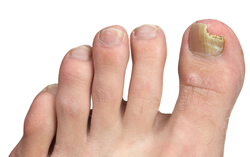Patient Education
Toenail Fungus (Onychomycosis)
Toenail fungal infections, also known as Onychomycosis, affects more than 10 percent of the U.S. population. It is an embarrassing chronic condition that impacts quality of life and can lead to serious health problems for those with diabetes or immune disorders. People with toenail fungus may experience thick, discolored, brittle, or painful toenails.
The agent responsible for nail fungal infections is usually a member of the group of fungi called dermatophytes. However, the toenail fungus may also be caused by yeasts and molds. They may enter a person's skin through microscopic invisible cuts or via a small space that exists between your nail and nail bed. Toenails are usually kept dark, warm and moist inside person's shoes, which is the ideal environment for the fungi to thrive in. This is the reason why these infections usually occur in the toenails rather than the fingernails. Injury to the toenail can also lead to toenail fungus.
When an infection attacks one or more of your toenails, it usually starts out as a white or yellow dot beneath the tip of ones toenail. As it progresses and extends deeper into the affected nail, the toenail begins to discolor, thicken and develop crumbling edges. This is not only unpleasant looking; it could also turn very painful. Toenail fungus infections are difficult to treat and are known to recur. While there are many toenail fungus home remedies and medications, most are said to be only partially or temporarily effective.


Diagnosis
You should see a podiatrist at the first sign of toenail fungus. Your doctor will review your medical history and examine your toenails. A nail biopsy from underneath the edge of your toenail may be obtained to confirm the diagnosis.
Treatment
Treament options for toenail fungus include:
• Topical anti-fungal medication. Over-the-counter products are usually not very effective
• Oral anti-fungal medications
Prevention
• Trimming your nails straight across.
• Keeping your nails clean and dry.
• Using an antifungal spray or powder daily.
• Wearing shoes in public showers, locker rooms, and pool surrounds.
• Spray your shoes with Lysol frequently.
• Discontinuing the use of nail polish. Nail polish can trap fungus and promote an infection.
• If your feet sweat, change shoes and socks frequently. Fungus thrives in damp, dark environments.


